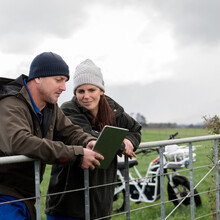Nutrient Management
BallanceEx - Phosphate loss
YouTube video - Ballance science strategy manager Warwick Catto talks phosphate loss with Professor Allan Gillingham
PROVIDER
Ballance Agri-Nutrients
BallanceEx - Examining Greenhouse Gases
YouTube video - Ballance nutrient science manager Sheree Balvert catches up with Pastoral Greenhouse Gas Research Consortium general manager Mark Aspin
PROVIDER
Ballance Agri-Nutrients
Winter Feed Crops: Management After Grazing
Careful management of paddocks after winter grazing can reduce damage to soil structure and loss in productivity, while reducing further environmental losses that could potentially affect water quality.
Critical Source Areas
Critical source areas (CSAs) are small, low-lying parts of farms such as gullies and swales where runoff accumulates in high concentration. This site gives options to manage CSAs to reduce runoff losses
PROVIDER
DairyNZ
Critical Source Areas
What are Critical Source Areas and how can they be managed to reduce environmental impact
PROVIDER
Environment Southland
Deer fence pacing: Costs and solutions
A factsheet looking at the causes, costs and options to prevent deer fence pacing
PROVIDER
DINZ
Protecting waterways from wallow and feed pad run-off
Good management practices
A guide to reducing contaminants entering tile drains
Many farms in Southland are dependent on an efficient soil drainage system to maintain pasture production and use. This is made up of subsurface mole and tile (pipe) drains that transport soil water to open drains and waterways.
PROVIDER
Environment Southland
Nutrient Management
Environment Southland is promoting the use of a nutrient budget as good management practice to ensure farmers gain a greater awareness and understanding of nutrient management for their farm.
PROVIDER
Environment Southland
Reducing phosphorus (P) loss on dairy farms
There are many options to reduce the amount of P that enters the environment. This page will help you identify opportunities on your farm to reduce P loss.
PROVIDER
DairyNZ
Effective Nutrient Management on deer farms
Things to consider on deer farms to ensure that nutrients remain in the paddock
PROVIDER
DINZ
Nitrogen and Phosphorus Filter Trials
Two filters were installed near the Waituna Lagoon in 2016 and were monitored for 3 years. This website explains how the trial was conducted, the potential of filters as a mitigation and the practicality of including this mitigation on farm
PROVIDER
Living Water
Water, soils and wallowing
Deer have specific natural needs and behaviours and if incorrectly managed, deer can threaten the quality of water and soil, cause erosion, compaction and pugging of soils, and the consequent runoff of nutrient, sediment and coliforms will result in contamination of waterways with undesirable behaviour including excessive pacing, wallowing, and digging in soils.
PROVIDER
DINZ
Nutrient Management on your dairy farm
A farmer’s guide to understanding how nitrogen and phosphorus enter, cycle through and leave your dairy farm
PROVIDER
DairyNZ
In stream sediment traps
This is an ongoing project which aims to capure sediment in lowland streams. Go to this website to get updates on the project and their findings
PROVIDER
Living Water
Constructed wetlands to reduce contaminant loss from pastoral farms
Identifying Contaminants
There are many options available to improve the health of our waterways. This page will help you understand the actions you can take.
PROVIDER
DairyNZ


